Contents
- 1. Importance of conch (shankh) as per scriptures
- 2. Blowing of shankh in puja ritual
- 3. Shankhini
- 4. Ritualistic worship of shankh
- 5. Important points to be noted while using a shankh
- 6. The bell
- 7. Difference in sound vibrations of bell and shankh
Namaskar! We heartily welcome you all for this Satsang (spiritual meet)! Before we commence this Satsang let us pay obeisance at the Holy feet of Sadguru (spiritual master) so that by His grace the very objective of this Satsang is fulfilled. Please pay mental obeisance to your personal icon of faith and recite as follows:
गुरुर्ब्रह्मा गुरुर्विष्णु गुरुर्देवो महेश्वर: ।
गुरु साक्षात् परब्रह्म तस्मै श्री गुरवे नम: ।।
In the previous spiritual meets we have understood the arrangement of temple room and the importance of it from the view point of spiritual science. We have also seen the spiritual significance of various articles of puja such as kalash, lamp etc. Similarly we have also come to know the importance of ghee lamp, its effect on the worshipper, the difference between the straight and puffed wicks in Sanatan Vaidik Hindu Dharma. The science underlying the importance of copper articles in puja ritual was also explained. We hope that you must have tried to take the benefit of the spiritual science explained in these Satsang by actually putting it in practice.
In this Satsang we shall make you familiar with other articles of puja namely, ‘bell (ghanta) and conch (shankh)’ from the standpoint of spiritual science.
1. Importance of conch (shankh) as per scriptures
First of all let us see the importance of shankh. According to our ancient scriptures that is Puranas, the shankh was originated during the Churning of ocean (Samudramanthan) by the Deities and Shri Vishnu held it in the form of weapon. As per a holy verse which is regularly chanted during the puja ritual it is mentioned that by the command of Shri Vishnu the deities Moon, Sun and Varun are stationed at the base of the shankh, the deity Prajapati on its surface and all the places of pilgrimage like Ganga and Saraswati in its front portion. Yet another specialty of shankh is that the vibrations emanating on blowing it destroys the disease causing germs in the atmosphere. That is the reason it has a important place in Ayurved and medicine.
Let us see a subtle drawing which explains us the importance of shankh.
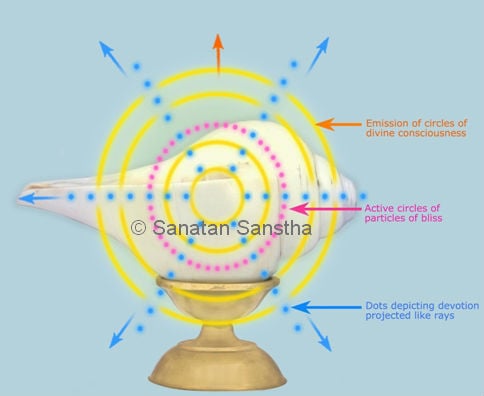 |
In this subtle drawing we can see that the yellow coloured circles of chaitanya are being emitted from shankh in the atmosphere. The subtle blue coloured dots depicting devotion are projected like rays in straight line. The pink circles are formed of particles of bliss (anand) and they are constantly active.
The shankh are of two types, namely, left turned shankh and right turned shankh. When the shankh is held with its spout pointed up, its spirals coil towards your right then it is right turned shankh and if the spirals coil towards your left then it is a left turned shankh. Generally a left turned shankh is preferred for the puja ritual. Now days so many Shanks of different shapes are available in the market. There are some figured works also on their surface. Thus one gets confused as to how a genuine shankh be identified? The simple test is that without blowing the shankh if you hear pleasant sound when you bring it near to your ear then it is a genuine one.
2. Blowing of shankh in puja ritual
The shankh is used in two ways in a puja ritual. One for blowing before the start of ritual and other for actual puja ritual. The shankh which is used for blowing should not be kept for puja.
Blowing of shankh has special significance in puja ritual. It has been mentioned in ‘Varaha Puran’ that one should not open the door of temple without first blowing the shankh. The left turned shankh is blown before the start of puja or performance of arti. There are three types of frequencies in the atmosphere namely sattva dominant, raja dominant and tama dominant. Among them the raja dominant and tama dominant frequencies generate distressing vibrations. The sattva dominant frequencies get attracted to the place of puja ritual but these frequencies are opposed by the raja and tama dominant frequencies so that they do not reach the place of puja and thus the flow of sattva frequencies is hindered.
When the shankh is blown before the start of puja energy is emitted from the shankh. This energy reduces the strength of distressing frequencies. Besides a protective armour of chaitanya (divine consciousness) is formed around the articles of puja.
There is another benefit too. That is when the shankh is blown the activated energy of Shri Vishnu in the universe gets attracted towards the place of worship which is not only beneficial to the person who is blowing the shankh but also to all those who hear it.
Just as the shankh is blown before the start of puja, it is also blown before an arti. The objective behind this being to sustain the deity’s chaitanya attracted to the place of puja ritual and the pure atmosphere generated because of the sattvik frequencies, for a long period.
2.1 Effect of energy emitted from blowing of shankh
Let us see how the energy is emitted from the blowing of shankh and what exactly happens with the help of a subtle drawing. Here we have to take into consideration the fact that while the vibrations of a subtle drawing are three dimensional we see them in the subtle drawing in a two dimensional form. For example the sphere will appear as a circle. Now let us look at the subtle drawing:
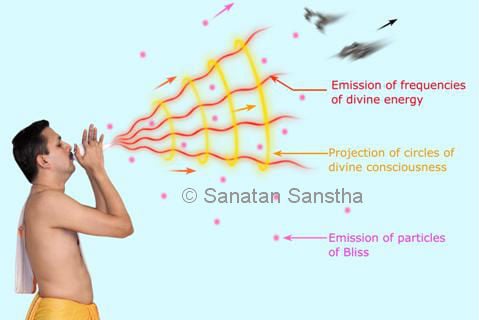 |
As soon as the shankh is blown the frequencies of divine energy (shakti) are emitted into atmosphere due to sound generated. These energy frequencies are seen in red colour. Along with these energy frequencies yellow circles of chaitanya are also projected in the atmosphere. You can also see the pink particles of Bliss being emitted in the atmosphere. This increases the proportion of shakti (energy), chaitanya and anand in the environment and that is why the negative energies get distressed and run away.
Thus it has become clear to us the importance of blowing shankh during puja ritual. The blowing of shankh makes the atmosphere holy and pure and conducive for the spiritual practice (sadhana) of the individual. Thus it becomes easier for an individual to receive maximum sattvik frequencies emanating from the deities.
2.2 Correct method of blowing shankh
We have seen that because of blowing of shankh the frequencies consisting raja–tama particles are destroyed and at the same time the saviour and destroyer principle of a deity is awakened. Now let us see the correct method of blowing the shankh.
First slightly raise your neck and bend it little backwards and keep the mind focused. Take a deep breath and start to blow with increasing intensity. One should keep in mind that blowing of shankh should be completed in one single breath. When the shankh is blown in this way Sushumna channel of the individual gets activated and it helps in keeping a correct balance of raja and sattva particles related to Tej and Vayu elements. This awakens the saviour and destroyer principle of a deity according to the need.
 |
3. Shankhini
There is another type of shankh which is neither supposed to be blown nor kept in the puja ritual. It is called female shankh or shankhini. Its surface is rough and thorny. It does not emit pleasant sound. Let us now see why a female shankh or shankhini is not used for blowing as per the science of spirituality.
There are several crisscross circles on the inner surface of shankhani. When you blow through it these circles create obstruction in the interrupted flow of sound vibrations. The sound vibrations when generated rub against these circles thereby producing distressing frequencies. These new distressing frequencies further activate the distressing frequencies already present in the atmosphere. Both the vibrations from the shankhani and those from the negative energies present in the atmosphere get attracted towards the place of puja and make the surrounding atmosphere impure. That is the reason shankhani is not used in the usual puja ritual. However the worshippers following the Aghori Vidya (worship to accumulate black energy) use the shankhani for attracting negative energies at the start of their worship.
4. Ritualistic worship of shankh
During puja ritual the shankh is kept in a specific way. The pointed portion is directed toward the deity.
The frequencies of chaitanya and energy emanating from the images of deities get attracted to the pointed portion of shankh. You can also see the blue coloured Shri Krushna principle getting attracted towards shankh which is producing a armour of Krushnatattva around shankh. The yellow coloured chaitanya is also attracted and spreads inside the shankh. The red coloured frequencies of energy are revolving in the space of shankh in a circular fashion. The frequencies of energy and chaitanya are emitted from the other end of shankh which purifies the atmosphere and thus benefits the worshipper.
When the shankh is kept with its pointed portion towards the deity then the house gets the energy emitted from the other end in required amount. Now let us know about ritualistic worship of shankh.
A shankh is filled with water prior to actual puja of a deity and following the puja of kalash. Then it is ritualistically worshipped by offerings of sandalwood paste, flowers and Tulsi leaves. After the shankh puja the worshipper sprinkles the water filled in shankh on himself and the articles of puja. The water filled in shankh is considered as pure as water of Ganga river. It is also used for giving holy bath (abhishek) to the deities.
5. Important points to be noted while using a shankh
Now let us see some useful points about shankh
-
Never use shankh meant for blowing in a puja ritual. They should be different.
-
Never offer water to the deity by shankh used for blowing.
-
Do not keep two shankhs for worship in a temple room.
-
Never touch the Shiva pindi with shankh during a puja ritual.
-
Never use shankh for giving holy bath to deities Shiva and Sun.
6. The bell
In the ritual of puja deity principles are attracted at the place of worship or in the idol with the help of various methods. The deity principle is then received by the worshipper participating in the puja. The articles used in the puja ritual work as an important medium of attracting the deity principle. That is the reason these articles are worshipped first to activate the divinity in them. Bell is one such an important article.
The bell is used mainly at two places – One which we use in our temple room and the other we see in the temples. First of all let us understand about the bell we use in our temple room. Nowadays we come across articles of puja made up of various metals. They even have different artistic designs on them. As per the science of spirituality the bell should be made from either copper or brass. The carving of images of Garud or Nandi is allowed according to scriptures.
The Sound generated by the bell should be gentle and sweet. In a puja ritual the bell is used during such sub-rituals as waving Frankincense (dhoop) and Lamp as well as while performing arti for creating gentle sound. In a puja ritual what is the importance of sound and what happens on spiritual level can be understood by looking at a subtle drawing. The subtle drawing means a drawing which tells us about the subtle process which is going on at spiritual level about whatever we see with the gross eyes about an object or action.
6.1 Effect of energy emitted from the bell
Let us now see how the energy is emitted from the bell and what exactly happens with the help of a subtle drawing.
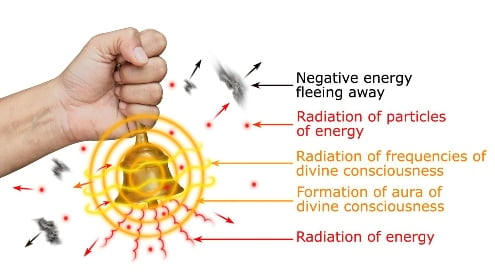 |
The dome shaped body of the bell and the clapper when strike with each other create circles of chaitanya which are projected in the atmosphere. The sound generated simultaneously also emits frequencies of chaitanya predominant in Akash tattva (absolute ether element). We can see them in yellow colour. The stroke of clapper emits red coloured divine energy rays. The particles of divine energy which spread in the atmosphere and are of red colour are also seen here. The divine energy and chaitanya generated by the sound of bell drives away the negative energies.
During a puja ritual as mentioned in scriptures when we do puja of bell as an initial part of puja, the bell is gently rang and following holy verse is recited,
आगमार्थंतुदेवानां गमनार्थंतुराक्षसाम् ।।
The purport being, ‘I am ringing this bell to invoke Deities and to drive away demons.’
7. Difference in sound vibrations of bell and shankh
Now you must have understood the importance of bell and ringing of bell. It must also have been clear that the purport of the holy verse and the knowledge obtained through the medium of subtle drawing match with each other.
One point is clear from the information we have got up till now that sound vibrations are created in every puja ritual with the help of two articles namely shankh and bell. Sound vibrations produced by shankh is called Shankhanad while that of bell is known as Ghantanad.
The common property of both of them is they purify the atmosphere. The only difference is that while the sound vibrations from bell purify the atmosphere in the downward direction while that emanating from shankh purify the frequencies active in the upward direction. Hence both of them are very important in a puja ritual.
|
For more information on this article read Sanatan’s publication ‘Temple at home and Implements used in the worship of God (Scientific Importance and Arrangement)’. |
Close-up: If you get any spiritual experiences by following the view points mentioned in this Satsang or if you have any queries about the topic presented today , please inform us. Our contact details are [email protected]

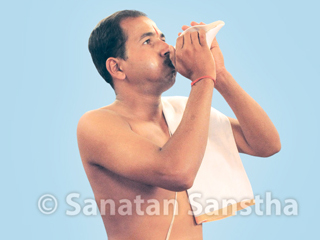
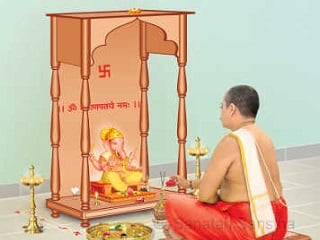 How to perform Puja Vidhi ?
How to perform Puja Vidhi ? Importance of Puja Samagri in ritualistic worship
Importance of Puja Samagri in ritualistic worship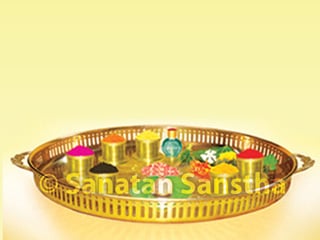 How to arrange the substances in Puja Thali ?
How to arrange the substances in Puja Thali ?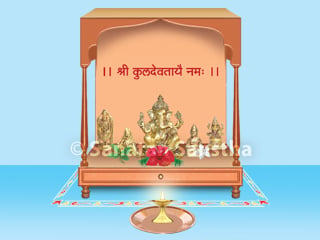 How should be the design of Devghar ?
How should be the design of Devghar ?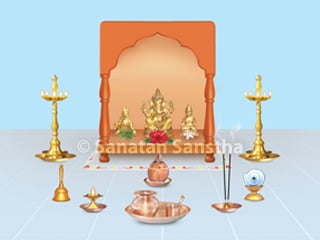 How to arrange the Puja items used in puja ?
How to arrange the Puja items used in puja ?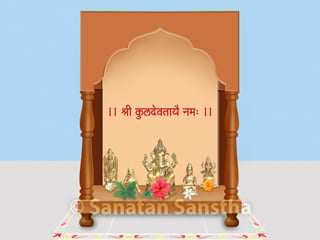 How to arrange Deities in Home temple ?
How to arrange Deities in Home temple ?
Nice information. Found another great read on what is Shankh and how to use it: http://www.rockingbaba.com/blog/index.php/2015/09/13/importance-of-shankh-conch-shell/